There are a number of reasons that you may want to have a steady supply of charcoal briquettes post-collapse as a prepper. For example, are you looking for a way post-collapse to keep moisture from playing havoc with your guns?
Why not make your own charcoal dehumidifier?
All you have to do is place a few charcoal briquettes in a metal coffee can, punch some holes in it, and then place it in your gun cabinet. Replace it every few months and you’ll have helped to nip moisture in the bud.
Perhaps you’re wanting an easy means of keeping charcoal handy for future DIY water filters. Perhaps you just want to cook your venison so that it tastes the way it should.
Whatever your reasons are, access to charcoal may not even be a possibility post-collapse.
Related: How to Make Your Own Charcoal?
Here is how to make your own DIY charcoal briquettes.
Here Is What You Need
There are actually a number of different ways out there that will help you to make your own charcoal, but many of them call for ingredients that you likely won’t have readily available post-disaster.
For a prepper, DIY charcoal briquettes need to be as simple as possible, and that means with as few ingredients as possible:
- Charcoal dust
- Water
- Cornstarch (or newspapers)
Provided you have access to those three ingredients, you can make your own charcoal briquettes.
Here Is How You Do So
Step #1 – Gather the black charcoal from a recent fire.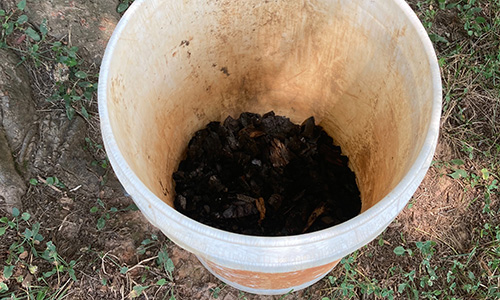
Make yourself a big campfire and burn down a lot of wood until it’s nothing more than black charcoal. That’s exactly what you want. Once the fire has died and the coals are cooled, gather up as much of that black charcoal as you can.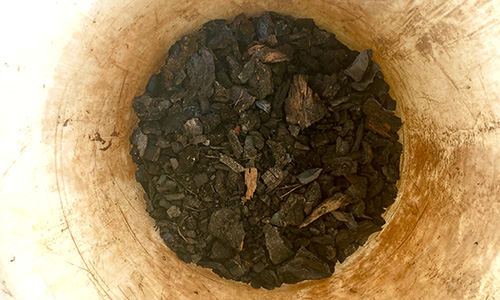
I avoid the white ash. Getting water on the white ash will make lye, and you don’t want to get chemical burns on your hands.
Related: 30 Survival Uses for Wood Ashes You Never Thought of
Step #2 – Ground your charcoal up into a small powder.
It doesn’t matter if you put it in a bag and hit it with a hammer, use a mortar and pestle, or smash it between a couple of rocks. Somehow, you just have to get that charcoal ground up into a fine black dust.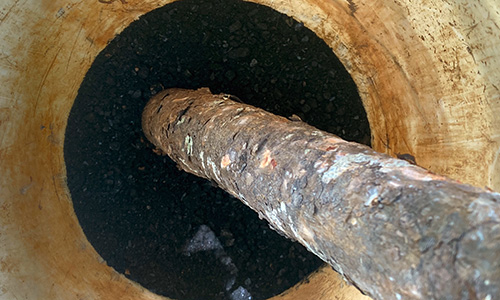
Do that with all of the charcoal that you’ve gathered, and then set it aside in some form of container.
I used a 5-gallon bucket and a big log from a pine tree I’d just cut down. You’ll feel like you’re churning butter going about things this way, but it gets the job done.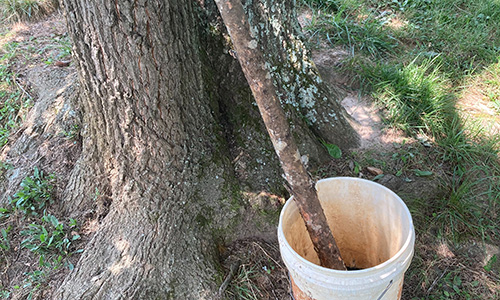
Step #3 – Using a stove, campfire, or some other source of heat, mix up your cornstarch and your water into a thick porridge-like paste.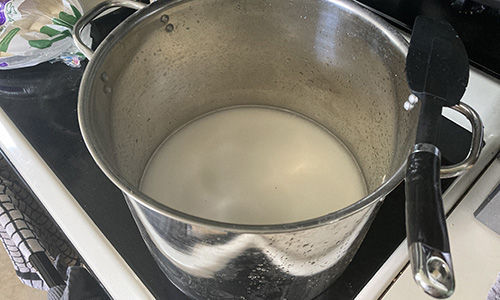
Your best bet here is to heat up the water while slowly pouring the corn starch in and mixing until you get the right amount. This is going to serve as your binding agent for the briquettes – holding all of the charcoal dust together into a nice, uniform shape.
While I don’t have a set recipe for how much cornstarch you’re going to need, I will say this: you’ll need a lot. It ended up taking me an entire container’s worth to get to where I felt I was getting close to porridge-y.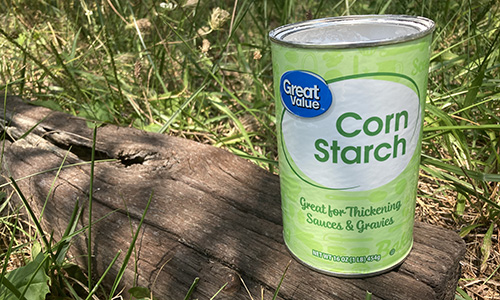
If you want something a bit more scientific, here are some actual recipes for making your own charcoal:
- 10 kg of charcoal dust and 0.3 kg of cassava starch
- 4 kg sawdust, 40 kg charcoal dust, 2.5 kg starch, 1 kg calcium carbonate
- 10 kg charcoal dust, 5 kg sawdust, 1 kg cassava starch, 0.5 kg limestone
- 10 kg charcoal dust, 5 kg sawdust, 1 kg mashed newsprint
In a survival situation though, you’re not going to have access to all of the various ingredients. Use what you have to make what you can. Survival is often about ingenuity with limited resources.
Step #4 – Mix in as much charcoal dust as possible.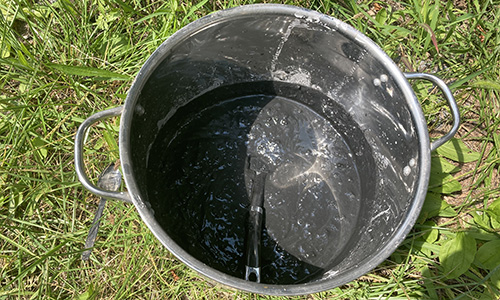
Stir in as much as you can here. The more you can get in there, the better. Ideally, quality charcoal briquettes are in the neighborhood of 90% charcoal.
Optional Step – Mix in Newspaper Shavings
This isn’t required, but I did it to assist with the lighting process. Newspaper can act as an accelerant within charcoal, helping to ensure your charcoal lights quicker. Seeing that paper is common in homemade cement style mixtures, I figured it would help the briquettes to bind well too.
I tore up two full sheets of newspaper into little pieces. If you have access to a paper shredder, or the ability to really get those newspaper pieces tiny, I would recommend taking full advantage of such. Doing so would increase the surface area of the newspaper, helping to give you a quicker lighting process.
Step #5 – Pour the sooty, gooey mess into egg cartons.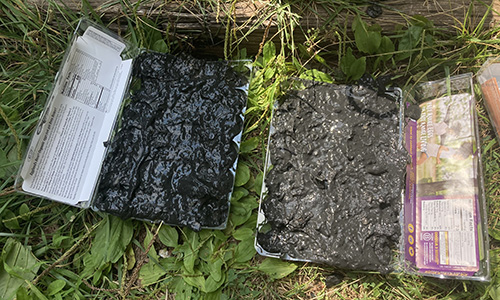
These are a great at-the-ready uniform means of shaping all of your charcoal briquettes. Once you’ve filled up as many of these as you can, set them to the side and let them dry. At the end of this drying period, your charcoal should be ready to use.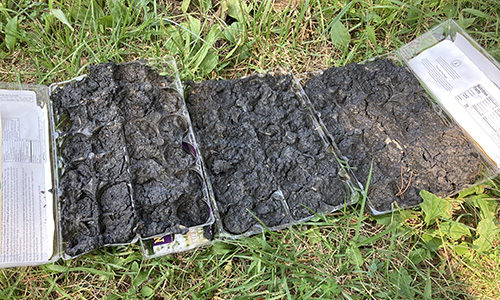
It took 3 days of drying in the Southern sun for my charcoal to get to the consistency I wanted it to be. On Day 2 I sped things up by sticking it in a solar dehydrator that had just burnt some tomato slices to little black rings.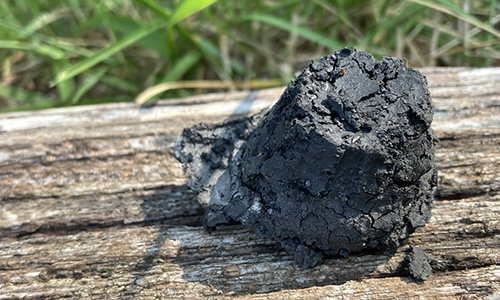
How It Worked
Like most of my attempts at lighting charcoal, I needed a bit of help to get these guys lit. While I’ve typically used lighter fluid in past grilling attempts, I figured that may not be available if you’re in a survival situation.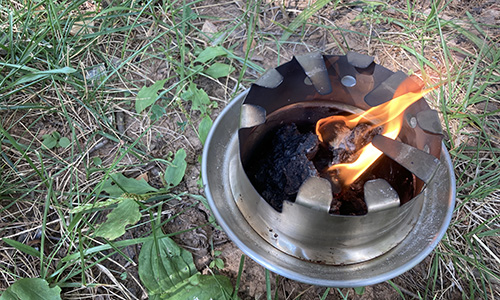
So, I used my favorite means of fire assistance: Vaseline-soaked cotton balls. I lit three of those, threw them in my hobo stove full of homemade charcoal, and ended up with a little fire. Using a little Lodge cast-iron skillet, I then proceeded to fry one of my chicken’s eggs.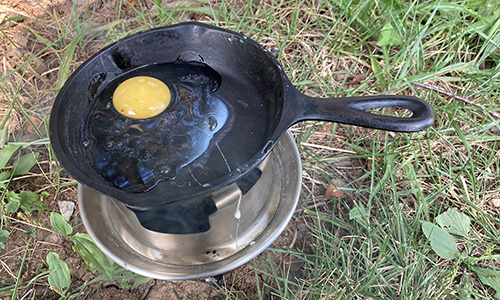
While the charcoal did burn down completely to white/brown ash, I do think this particular batch would have been better served via adding more accelerant to the mix. There’s no doubt in my mind that the black ash component was 90+% of the total mixture as desired. More newspaper is what should have been added, however. That would have enabled a much better burn.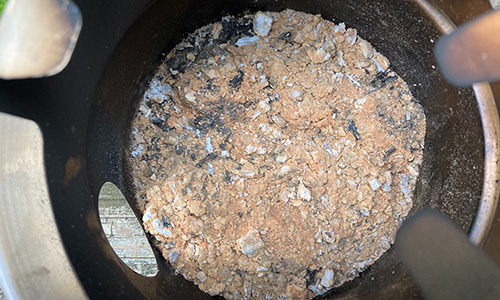
Black ash in and of itself doesn’t end up drawing enough oxygen to burn really hot. Accelerant is what makes that happen. Should I have had a significant amount of sawdust, or more finely shredded newspaper accessible, this would have resulted in an even more potent batch.
That being said, the charcoal of this batch worked just fine, it just needed a bit more oomph.
Embers of Conversation
Making your own charcoal is quite a bit of work, but it is doable. By the time you pound ashes into dust, heat up your starch mixture, stir a big vat of glop, add accelerant, pour the goo into molds, and let everything dry, you’ve expended quite a bit of effort.
However, if for whatever reason it’s charcoal you need in a survival situation, there is a way to do it. Hopefully, you’ll have found the above informative and a good addition to your mental toolbox of DIY survival skills.
What are your thoughts on the subject though? Have you ever made your own charcoal before? Did you use a different recipe? What have you used as accelerant in the past? Let us know in the comments below!
You may also like:
 How To Correctly Choose Your Survival Knife
How To Correctly Choose Your Survival Knife
This Homemade Device Can Power Up Your Entire House 7 Days in a Row (Video)
20 Last Minute Ways To Prepare For An Emergency

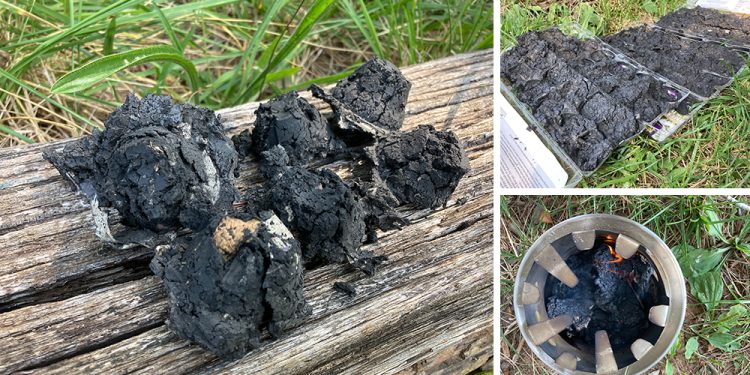




















Help me understand, please. I understand avoidance of white ash. In fact collecting the white ash for homemade lye gives it a separate value. The black char is what you need for charcoal. But, isn’t the black char already charcoal? Aside from increasing volume, what is the point of pulverizing and adding additional ingredients? Wouldn’t the burning of wood with restricted oxygen yield greater volume without added ingredients? Thank you for the article and any clarification.
The reason for pulverizeing and added ingredients is so it will bind togeather, so it will be in a solid form. A briquette…
It’s already a solid prior to pulverizing. Why pulverize, add ingredients and glue back together?
John
Yes it is a solid, but very porous. The object is to make a very dense product to last longer.
The more compact something is, the harder to get thru it with what ever it may be. A drill bit or burning it in a fire.
Lasting longer is the key…
Hi, I have never made charcoal but I did research how to do it. I’ve read the conversations here and they are correct but it seems like it would be a lot of work for a small amount. What I learned from my research is to get a large metal drum/w lid. place the can in the middle of your burn pile if you have one. Fill it with wood (some types of wood are better than others for this, I think the heavier woods might be but hopefully someone here would know) and then place the lid on loosely. Build a fire around the drum and “cook” the wood. I don’t recall how long but I think over-cooking is what turns the wood to charcoal. If your property doesn’t allow for such a large fire, (the following is my own idea) use a cast iron dutch oven and bend a spoon handle over the edge where the lid sits to keep the lid loose so the moisture can escape and place that on a fire pit (They sell all manner of outdoor fire pits at Lowes and The Home Depot so that leads me to believe that it would be legal in most places to have one in your back yard.) This too makes smaller amounts vs. the drum but it could be an everyday or every weekend event so you could collect a sizeable amount for your effort. Lastly you simply break up the charcoal. Also, have a large metal trash can somewhere near your clothes dryer. collect the lint from the filter after every use and store it in the metal can. The metal can will keep it dry and protect the lint because it is flamable(also makes it a bit safer for indoor storage). It would make a good fire starter if you have no lighter fluid and keep your newsprint to make toilet paper, LOL (. i know this doesn’t help someone in a duplex or apartment building but someone with a yard could do it. I don’t mind critics either, since I have never done this someone else may know more about it. I would also collect the black remnants of the fire that cooked the charcoal and follow the recipe they have here to make the briquettes so even the tiny bits that are shoveled up from around the drum can be more uniform and burn as well as the rest.
Pretty good amount of work for such a small return.
I can see this working in a community or a long term sinerio for a smaller group. But not good for a Lone Wolf or even as a couple.
The easier way will be the choice.
It is good to know how to make this,. maybe you can make it, then use it to barter with.??
Hope all are ready, they say we are going to have a hard year, next year, big changes for the one’s that know all this is a LIE. not much change for the One’s that believe it and want it and going along with there AGENDA.
it’s going to get WORSE… mind blowing.
Big changes coming and “They” will make sure of it.
good luck and enjoy these last Thanksgiving and Merry Chirstmas.
might be the last time.
2022 better or worse…?
Hey red ant. Hope you’re keeping well. Don’t think this will be our last thanksgiving or Christmas. Most people made it through the last great depression. At the next holiday seasons we may just have a little less food but as long as we have our family with us safe and sound isn’t that the most important thing? Hate being negative but my feeling is that ’22 is going to be worse than ’21 was.
We still have a long way to go before we hit bottom.
Don’t like doing it like this red ant but I have to ask you something fairly important. I know you’re down in the lone star state and you guys have a lot of wild boar down there. Now those darn things have made it far enough north so that they’re basically on my doorstep. What is the best rifle to use to take those sob’s out. We don’t have assault rifles up here. Have a great day and thanks.
Hello Armin!!!
So good to hear from you.
Yes we have those Hogs down here and they are a big problem.
Haven’t gone in a long time but I have seen some people use a pellet rifle.
Don’t think I will be trying that. My cousin went hunting and got attacked and cut his leg real bad with it’s tusk or teeth what ever you want to call them. Laid him open and then tried to finish the job by attacking the cage, he had to jump up on it to get away from him. mean old boar.
But if you are trying to kill me, I to will be very pissed off. lol
My self almost got bit by a big old sow, long ago. She had some piglets and I got to close and she tried to rip me apart. If you are not fast at running. Don’t go hog hunting.
Okay back to what caliber you will need to kill a hog. well I haven’t gotten to be that lucky to use a small caliber to see if it will work or not so I carry a 45 pistol and a big knife that I keep on my side and then a 3006 or a 223 or a shotgun.
Now the shot gun is for fun, but I don’t think you will want to get that close, we are a little wild down here.
It’s to see how close you can get before you have to shot it. Fun but scary and a little nutty…
WE have grown up a little scenes that time. very little but some. lol
I will say if it starts to charge you, do not try and shot it in the head. They have very hard skulls and can deflect a round and then you have a hog up you back side before you can react.
They are very fast and can go thru stuff that we can’t even see thru.
My boss uses a thermal to see then on his ranch at night.
Better for you to see them then they see you when it’s pitch black out side and the sound that they make when they are out there and your walking along the creek bank.
It will put CHILLS up and down your spine.
So if you get one that close, I say don’t run but keep your eye’s on him and get up on something. If you can kill him or her then if it’s not to big, about 40 or 60 pounds then take it and butcher it up and use it for food. But be careful the bigger ones are very nasty and stink really bad and the meat can also be very stinky and not pleasant to eat.
A sow that is milking is the best to eat. She is cleaner when she is milking. Shot her and butcher it up.
Wait till you see a hog that is over 900 pounds, now that is a site to see. Big and very nasty.
Now I want to go hog hunting so I will set up a little hog killing one night here soon.
Got me pump up.
I think we will be dealing with hog for a good long time.
I hope you are right about the Holidays, But I don’t think they will be around for next year. but will see. I hope.
Armin keep seeking God and stay close to those that have loved you all the days of your life, even before you were created. Seek HIM…
So happy to hear from my old friend from Canada, A…
I think I did that right. lol
Happy Hog hunting.
Armin: Yeah, farmers in Penna and New York are finding killing off wolves was a very bad idea. They’re a major predator on baby razorbacks. Watch out for more moving into southern Yukon. About a decade ago, some idiot released Siberian boar on his property in Alaska. They caught most of them, but, I was told, a pregnant sow escaped. Razorbacks are descended from Russian boar, and can sleep thru much of winter like a bear will. Ours spent winter in deep bedding (they would brink in piles of leaves and cornstalks and shred them to burrow in). Hogs are sly, smart, and learn fast, and are predators; and we’re on the menu, if they think they can get away with a kill. niio
In that great depression there was no COVID or what else they have planned to release on us. Monkey pox is already here infecting people. Are Ebola, Marburg, or other deadly diseases ready for release?
RA: Lone wolf is a dead wolf.
I stopped worrying about the future after BO stole the first presidential election he was in. As God will point out, if you ask, he was a spanking that turned out to be for our own good. It created a landslide for Trump even dominion couldn’t overcome. And now, Dominion is looking at the rope. Pelosi wants to retire to whatever estate the chicoms gave her for being a good pet, so who will be 3rd in power? Ask soros.
Hogs, as I was taught, are the only domesticated animal that will bite off the hand that feeds it. What does that say of razorbacks? We have very few in Arizona. They need a lot of water to survive. The best trap I ever was what we used to tame pigs. Our sows were pastured up in the brush on the mountain, but had to be brought down for breeding, then when they farrowed, the pigs taken care of. The trap was about an eighth of an acre, if that, and had been used for almost 300 years by then. They were fed and watered there and that tamed them and kept the pigs from growing too wild. Like all liberals, hogs will sell their soul for a bite to eat. Even when oak mast and so on was thick, they’d run to the trap for a bucket of corn or some sweet feed. niio
Aden, Thanks for the article, this is one I will keep.
John, on very cold night’s I place some store-bought charcoal briquets in my wood stove to keep it warm longer than just plain wood. The briquets are compact and burn slowly. If you look at the second picture in the article, Aden uses mostly wood chunks from the fire not the ash. These chunks are considerably less dense then charcoal and will not burn as long. I could use coal but that’s very messy and not as readably available where I am.
Red Ant, having them for barter is a great idea. I hadn’t thought of that. Thanks.
This is good to know, but not practical for me here in the big city. I’m sure the neighbors would complain and I might be paid a visit by the NYC FDNY for outside burning of garden waste! I’ll have to stick to stocking up on charcoal from the local market when it is on sale! There are all sorts of regulations here about the storage of combustibles in residential areas, but I’m pretty sure a reasonable amount of charcoal is OK. Gas grills have only recently been allowed in residential parts of the city.
This is probably a stupid question, CC, because if you were able you probably would have done it already. Any chance of you escaping the big apple to a safer location. And if you did have a chance to move where would your first choice to move to be?
using charcoal brickettes as a dehumidifier….can i just buy a bag of brickettes or do i need to make my own.
Can buy. Or spend extra for a bucket of them sold as a no power needed dehum. Like I did first time
Armin – Actually, I’m in a safe location. I’m well travelled, both domestically and internationally and I’ll take Long Island NY. There’s no place like home!
I’m relieved to hear that, CC. I can’t see 2022 being any better than this year. Keep your ruby slippers handy and stay safe. 🙂
Oriole, Yes your can just buy some but do not purchase the fast lighting ones or the ones that say, no lighter fluid needed. They will stink up your house with the chemicals they are doused with.
Stack firewood in a steel barrel, let it burn until the outside begins to char, then cover barrel tightly with lid and leave it overnight. That is how you make charcoal, the wood smolders in the absence of O2 . Or dig a big pit, get a good burn going and cover the fire with dry soil. It will burn down to charcoal. Break limestone into fist size chunks and burn it in a hot fire, covered with soil, and you will make white lime.
I was thinking along the same lines, Judge. If I was truly thinking ahead, and I have a lot of wood on hand, why not make charcoal every time I light up my barbecue. Don’t have to make a lot at a time. Even a little every time I fire up the barbecue would add up over time. To make charcoal you could almost think of it as “cooking” the wood instead of burning it. For a container, so it wood fit in the barbecue, something like an old pressure cooker that you could screw down and seal. Keep the air out. I don’t think making charcoal produces THAT much pressure so you could block the release valve. Although making charcoal might still produce wood gas so I might have to take that into consideration. Any thoughts?
The wood gas burns off before you cover the fire, otherwise your cooker would flame up like a space shuttle. It does take practice, the only thing I ever got right the 1st try was making aeoli from scratch, and it has never come out right since.
Actually for a first timer, I would recommend a steel biscuit tin, 3 holes punched in the bottom, fill with wood chips, put the lid on and place in a fire. Watch the fumes that come out of the punched holes light up, let it burn until they go out then remove from the fire to cool. I do this over winter with my open fire in the house. Each day I collect my tins and each night I burn them. In the morning each tin is half full of black carbonised wood chips, basically pure carbon. This is then activated with pee, worm castings, compost tea etc and used under fruit trees or in the garden as biochar. In most other scenarios I would rely on a rocket stove or a rocket mass heater for cooking/heating. I won’t have access to corn starch or newspaper after and they have other more useful purposes to me if I did. YMMV
Ginny: No canna lily? Achira makes much better food grade starch than maize. It’s easy to get, as well. thousands of people just grate the root in water and the starch separated from the stings. Starch noodles are still a radical favorite with little kinds in the family. But, call them invisible noodles. We used to call the glass noodles, but got a call from the school demanding to know why we were feeding little kids glass, sigh.
If it’s a problem to grow in your area, save the seeds and plant them in a new bed. After a few ‘generations’ it should be good. BTW, the old-timers would clean the roots, then slice thin and dry, then crush for flour. niio
Hi Red, yes I do have what we call Queensland arrowroot which is the food canna lily. Forgot that lol. Still think I would use it as a food rather than a binder in briquettes to burn. But then again I have plenty of wood both large n small for burning. At least I don’t have to worry too much about cold weather like you guys get, just the heat and the sudden influx of snakes now spring has sprung 🙂
Ginny, yes! Arctic cold weather all the way down to 45 F tonight! But, was thinking more along the line of achira as food. We’re planting seed because we can’t find the old varieties, drought tolerant the old timers raised. niio
Red, I’ll have to look up starch noodles as I’ve never heard of them. I think you suggested this plant a few years ago and I acquired some and have been expanding it around the garden. This year some is going further out and along the creek where I planted willows this year. The patch that I planted which gets no extra water was a bit stunted over last summer but came back fine with cooler weather and survived quite well. With summer water every once in a while or planted along the leach drain even would do better. This and proper arrowroot are very starchy but I would use this as a food source, like stealth gardening, rather than as a binder in briquettes. My cannas have a very bulbous red root (white inside) as large as an apple or orange sometimes, often smaller when it’s dry with a rather small red flower, certainly not like the popular flowering garden varieties. It has never set seed to date.
The idea of briquettes is good, I just don’t see how I could apply it to my situation, or rather I have other things that those ingredients would be useful for also. Even when I clean out the fire place I save all the charcoal for the next fire and only the ash goes into the garden or wherever. The char I made in tins was for the garden, some experimenting in the worm farm and putting under some new trees. I’m hoping that it will help drought proof the trees a bit. Soil carbon is very low on these old farms but with a few changes we’ve been slowly increasing it. Being able to produce larger quantities of biochar would be helpful but it all comes down to time in most cases for us.
Thanks, Judge. Basically mayo with a bunch of garlic in it. It’s a COLD sauce. I mean how difficult can it be? Personally I’d use miracle whip because I can’t stand mayo. Love garlic. Gotta try making aeoli some time. Sounds really good. Use it as a dip for crackers. Or even try tartar sauce with a bunch of garlic in it. You guys give me so many good ideas! 🙂 See if I can make a little charcoal.
You described the major step in making Biochar.
I used a 20 qt stainless steel pot with matching lid.
I cheated a bit though.
I used store bought oak wood heating pellets.
Filled it about 7/8ths of the way (yes they expand when heated), placed it in a wood stove, placed lid on top, placed wood around it and a decent log on top to hold the lid on.
Lit the thing and made sure that I kept the fire going and pretty hot.
1st thing you see is steam coming out, then the offgassing (usually methane but has CO and hydrogen and other things too).
After about 3 hours or so, when it stops offgassing, I wait another 1/2 hour to an hour in the stove to be sure.
Then remove it and KEEP THE LID ON!.
Let it cool naturally.
One 40 pound bag yields about 2/3 of that as fine charcoal pellets.
Not only did I get the charcoal needed, the offgassing burned and added heat into the system along with the wood.
So there was very little waste.
Be aware that many of those stock pots have aluminum rivets that MELT OFF. You may have to get some steel matching screws and nuts to reattach the handles.
I used mini logs in that at first. Those can take all day to convert depending on the type of wood used.
Outdoors, you can pyrolize even green wood. In fact you can use any organic matter (grass, BONE, etc).
For me, I needed to do some additional steps to create biochar. But if all you want is charcoal, I gave an easy way to do it.
If you cut wrist sized logs about 3 inches long (roughly 8 CM), and convert them, they will make roughly the right size as your home prepackaged briquettes.
Wood will shrink as it converts.
Avoid using unseasoned wood inside of a wood stove!
It will create creosote.
If you use my method, you can buy powdered lime and use cornstarch as your binder.
Mix well. Grind further, add a little water, then shape.
If you used the same stock pot, gently place those briquettes in it and lightly heat until dry.
Sun drying takes far too long to do. Especially in cool, humid, or rainy locations.
About white lime – why not just toss that in with the wood you are trying to pyrolize?
Kill two birds with one stone.
Very good description Crazysquirrel. We did some biochar using a 44gal/55gal drum as our retort but while it does give a lot of char it also takes a fair amount of heat and time to convert which I don’t have some days. Your smaller setup would be ideal. I’ll keep a lookout for something that size. I’ve burnt out so many small tins they don’t last that long.
This may work but I wouldn’t cook over it, it has ink contaminates .
another use and a very important use is to make black powder, 75%potasium nitrate 10% sulfur and 15% charcoal (black powder recipe.
to make very clean charcoal, take a all metal paint bucket, (that you have already burned off the paint . this is called a Charcoal Retort.
poke a small hole 1?8th of an inch, then put the bucket filled with wood pieces 2 or 3 inch’s in size, in a fire, when the vent hole stops burning a flame you will have burned all the resins and contaminates off (no wood ashes to deal with) and they are ready to cook with or make filter charcoal or for making black powder. It needs to be super pulverized and mixed and screened there are many instructions for this on the internet, do you homework. Black powder is very safe as long as your not stupid with-it (Its very flammable)
All newspaper inks are Soy based and food safe now.
At the printing company I work for, we use soy ink on 85% – 90% of our product lines and solvent-based ink for the remainder. On the cans of soy ink we have, there are health warnings for eye, skin, stomach, and lung irritation. Not exactly food-safe ink but definitely safer than inks we used to use.
If you can secure a lid to that container, you could invert the container and let the offgassing help speed up the process by adding heat to the bottom of the container along with the fire.
You need to burn the container another 30 minutes to 1 hour at high heat to ensure that all of the resins and such are completely removed.
And let the container cool naturally before opening. Too soon and it can flash back.
also do not remove lid till completely cool or it will catch on fire and burn up.
If I bought charcoal briquettes from the store for long term storage, will they absorb moisture from the air and ruin them?
Just stored in the bag charcoal will go bad in a couple of weeks and be almost impossible to light, I ruined a couple of meals before learning to keep it as dry as possible.
My experience was different, Judge. I just leave it outside all the time and it rains and snows on it. When I want to cook with it I plan ahead and just put half the amount I need somewhere to dry. Usually IN the barbecue. 😉 When it’s dried out again light ‘er up. Pour a little splash of kerosene on it to light it. Little dab’ll do ya. The charcoal lights. The kerosene burns off. No more kerosene smell. Put the other charcoal that I might need on the OTHER side of the barbecue to dry. It dries out while the barbecue fires up. Cook my food. If it looks like I need more charcoal just put it opposite the fire. Works like a charm. 🙂
Charcoal can be dried with any source of moderate heat. I’ve salvaged plenty of “rained On” partial bags of charcoal from friends and neighbors.
I must admit never thought of using charcoals affinity for moisture as a desiccant. 🙂
I suspect plain old steel can charcoal will do as well as this home made briquette as described.
As a gardener I have better uses for news print and lime.
I agree Armin. About 12 years ago, a discount store (a real cheap place) went out of business and was selling the large bags of charcoal briskets for .50. I bought a couple pallets (the reason I bought so many is a whole other story). We don’t cook in our kitchen because there is no room now (homeless family members moved in). We keep the brisket’s in a room off the spring house. We do the same as you. Dry the next batch in the grill as we cook on the other side. I killed a 250lb young boar with a 30-06. It was a terrible kill and I still feel bad about it. He was just hanging with his friends and I killed him Sure we ate him, but it was not sporting. Now, a CRAZY, WILD boar attacked our group later that day. We were able to climb into a truck bed. My husband got him with a .270 at over 100 yards a bit later. But maybe the boar was retaliating??? I don’t know. I have nightmares about me killing the young boar. I will hunt to feed my family. But there is a Super Walmart a few miles away that sells pork shoulder. Hunting was expensive and clearly I am not good with what I did. A guy at our gun club uses a .22 magnum and gets the boar between the eyes. He says you have to get the shot placed exact because the boar’s skull is thick and very slanted. That is what he says anyway.
spike
I have had some in buckets for years now and they are still good. Yes prep them.
Keep dry as best that you can.
I treat all my preps like they are made of gold.
I keep mine in metal trash cans. I call them my super-sized canister set!
Red Ant,
I have quite a few mostly empty 5 gallon motor oil buckets. Throwing the briquettes in there with the few ounces of left over motor oil would be good? I would be more confident of an air tight seal compared to trash cans.
spike.
Man just got off work. long day.
Me, I would not do it unless you at leased clean the buckets.
Would contaminate the good with the bad. I say clean them and then fill and prep.
Now if you want to run some one out of some place they would work good for that.
Remember you have to use what we have. Take care of it.
….
Is there a YouTube channel for AskAPrepper?
Never thought to ask.
https://www.youtube.com/channel/UCsFZLpSDLfKpSCff3-bHSYg
Ty
We were going to build a horno, a Hopi oven when my youngest son was still here. They’re easy, two chambers in a pile of dried adobe. On Townsends (youtube) he shows how military cooks built tabletop ovens when on bivouac.
One thing Pueblo used them for was charcoal. Small logs and twigs would be packed into the horno, then wet adobe used to fill the upper opening, and most of the lower. they would leave a hole into the lower part, the firebox, and stuff in kindling and pine needles. set that on fire, and went it all started to catch, plug the hole and the short chimney. Let it go for several days till it cooled, and with a lot of caution, open the chimney. mind that gasses can build up, and if there’s a spark, can blow off the top of the chimney. If no smoke if present and it feels cool, then the firebox. It should be good charcoal, and what was put in the bakery should be charred well enough to use for medicines like teeth powder and purifying water.
I like that better than taking the horse to scrape a hole in the ground and have to tend it for 3 days. niio
Good information since charcoal briquets probably will be a scarce commodity.
I do use them in the basement where I store things since some moisture down there. So they work well even not just keeping moisture out of a gun cabinet.
Thank you for the article. It was really good. If I decide to make my own charcoal, I will more than likely follow you recipe.
However, I simply must ask, why bother using charcoal at all? I cook on a wood-fired grill. I have for years. All I have to do is buy cherry, apple, walnut, pecan, hickory, mesquite, etc., and chop the pieces, lengthwise, so that they’re about half the size of what you normally would put into your wood stove or fireplace.
Then again though, using your method to make charcoal with the charred remnants of the wood that I’ve already used in my grill. Then I would have flavored charcoal smoke (cherry, apple, etc.) coming from my coals!
This way, all the wood I use can eventually be used again in the form of charcoal, which would lessen (or at least slow) the consumption of resources and reduce waste.
It would also make for some pretty awesome homemade gifts. When you go to visit your father-in-law, bring him a nice bag of hickory-flavored charcoal. I like this idea.
But PLEASE, do your body a favor and STOP using lighter fluid! The fumes, soot and even the liquid itself (sometimes) gets into the food your cooking. Then you’re literally eating petroleum, or at least petroleum byproducts.
Just get yourself a “chimney starter”. If seen them for a little as $6 and a much as $20. All you do is fill it up with charcoal and take a wad of paper towel (or just paper) sprayed lightly with vegetable oil, and put it under the bottom (there’s a ring around the bottom that elevates the coals so that you can do this). Then you just ignite the oiled paper, in top of your grill, and 10 minutes later all the coals are lit and burning red hot. Then you just lift up the rack, pour the charcoal briquettes into the grill, replace the rack and you’re ready to cook! This method is so much less harmful than getting “lighter fluid flavor”, and harming your health and your environment.
Yes, you could also use newspaper spritzed with vegetable oil, but then you’d be breathing in and eating ink-smoke. No thanks!
Again, thank you for the recipe though!
Russ
Thanks, Russ. I’ve seen people using a “chimney starter” and after reading what you’ve written may spend the couple of bucks and get one. Stay safe. Be prepared.
Always my friend. Always!
Russ: Good idea. The idea of charcoal is it burns much hotter than the wood its made from. It’s also a medicinal. And, you should get enough from your firebox. We have a gas grill, and still are using the same bottle of gas it came with 3 years ago. It’s been a little dry down here (Arizona) and there’s no need to set the world on fire. ! What we need to do ASAP is set up a Hopi oven, a horno, but use it with caution. niio
Yes, the fire season started here a month ago, by the end of the month all outdoor open fires will be prohibited for 4 months or so. I can still use the BBQ except on Total Fire Ban days. On those days no open flame allowed anywhere. Sounds regimented but some people have no common sense, or worse, light fires deliberately!
My solar oven comes into it’s own for the next few months lol
Could you simply use paper egg cartons (as opposed to foam or plastic), cut them apart rather than unmolding the charcoal, slather a bit of petroleum jelly on the paper carton part, and light them that way? It would seem a bit easier to me than having to unmold the charcoal and then use the cotton balls…..but there might be good reasons for doing it as you did that I don’t know..
For a fire starter, one or two, yes. Too much oil is not good for the chimney and too much heat can cause a chimney fire. A brother-in-law had a pellet stove that his son was supposed to keep filled. Almost every day the kid let the fire go out. he used waxed cubes as a starter. these were recommended by the manufacturer for the stove. By spring, the thing was ruined. niio